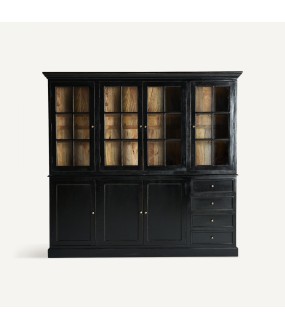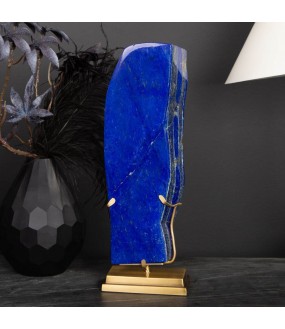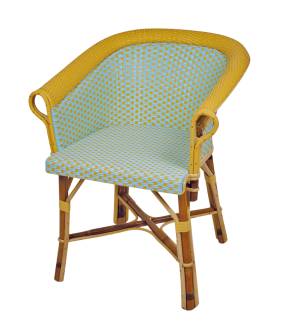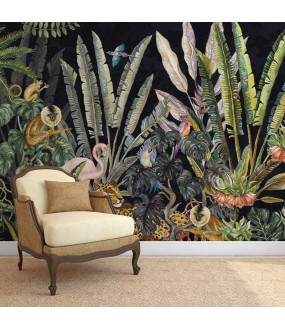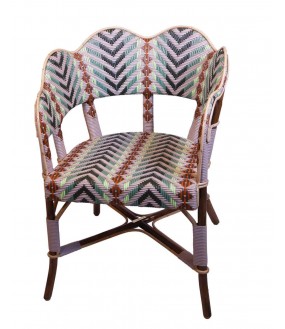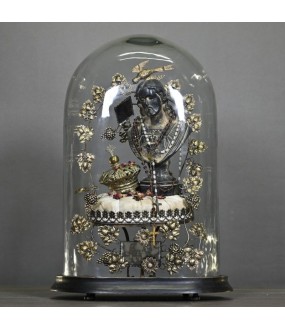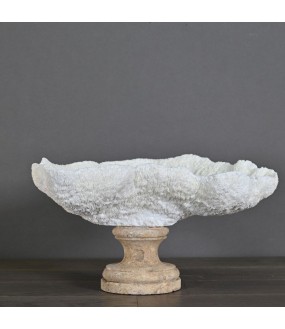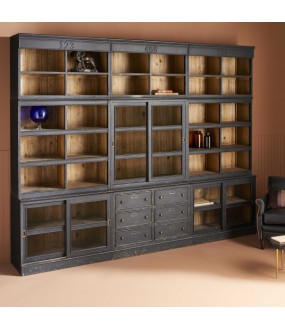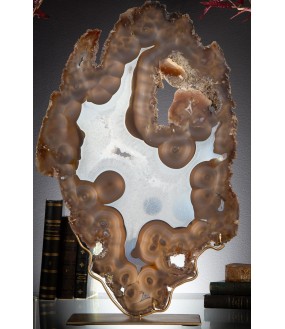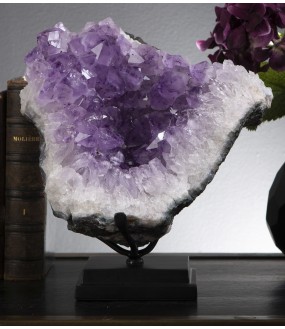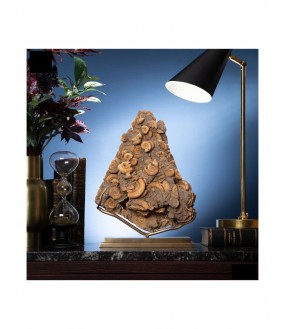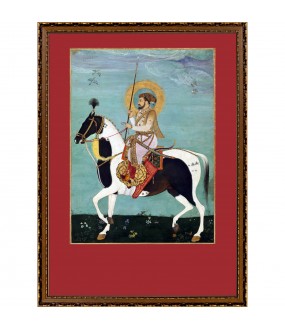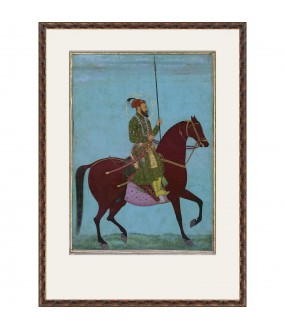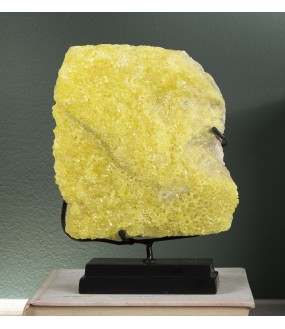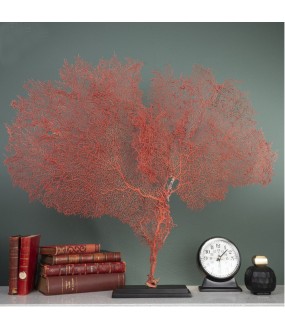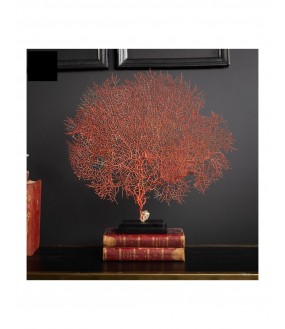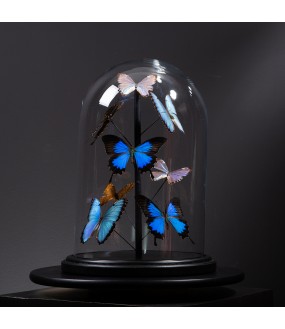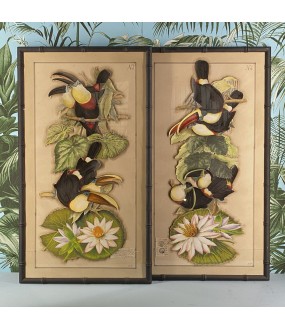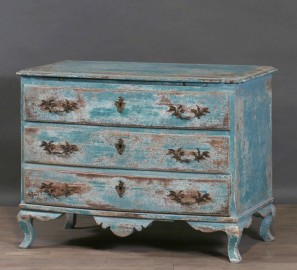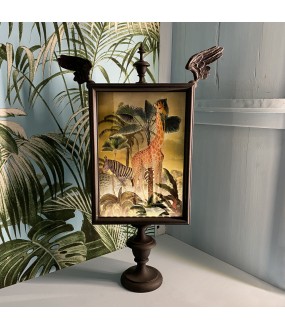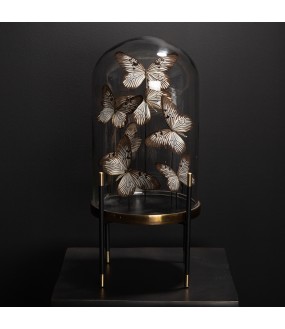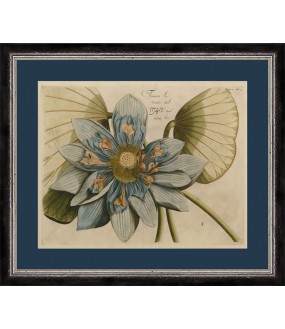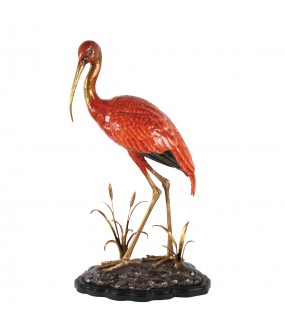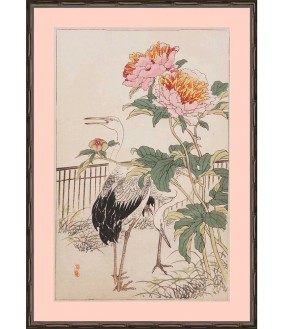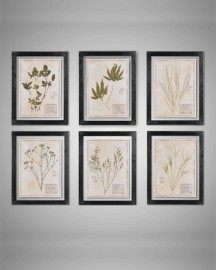New Items

Find all the new interior decoration items of Arteslonga: sofas, chairs, objects of curiosities, decorative accessories...
-
Library Edgard XIXth Style, Double Body
€5,280.00The large Edgard library consists of a double body and has the particularity of having an apothecary style from the beginning of the 19th century.
This large bookcase, made entirely of solid mango wood, is made up of 2 independent modules, top (dresser cabinet) and bottom (sideboard), which will dress your interior in a majestic way.
The two upper and lower parts can be offered for sale separately.
The aged black patina and its solid old mango wood interior give it an old look as if it had come out of a natural history museum.
The complete piece of furniture (upper and lower part) measures 430cm high by 218cm wide by 42cm deep. Total weight 170kg.
Dimensions of the upper glazed part which consists of 4 doors and 4 shelves:
Length: 218cm - Depth: 42cm - Height: 113cm
Dimensions of the lower part which consists of a single block of 4 doors and 4 drawers:
Length: 212cm - Depth: 40cm - Height: 92cm
This large bookcase will also go very well with an industrial style.
Delivery on the ground floor only.
For upstairs delivery, please contact us.
-
Lapis-lazuli with brass base (2,8kg)
€1,800.00Lapis-lazuli block of 2.8 kg on a brass base from Afghanistan.
A wonderful unique piece!
Lapis-Lazuli, whose royal blue color is highly sought after, is the most famous of the stones linked to intuition. The great rulers of the world (Pharaohs, emperors, kings, etc.) have always considered it a sacred stone intended to help them achieve on g-reign with wisdom and justice. The Egyptians in particular held Lapis in high esteem and imported it from Afghanistan where it has been extracted for 6500 years.
Lapis-lazuli has therefore always symbolized royalty, that is to say the ability to reign over one's inner and outer kingdom q-guided by the intuition of a divine source and not by selfish personal will.
The gentle energy of lapis will benefit those who are willing and in control. It will promote subtle listening and afuidity in their actions, which will ease tensions.
Lapis has the reputation of also being the stone of friendship because it helps to intuitively perceive what is right in a relationship, so it will have its place in your living room such as the living room, living room or a desk.
The most beautiful Lapis Lazuli come from the province of Badakhshan in northern Afghanistan. In a narrow valley, covered with snow most of the year, mines have been exploited for 6500 years!
The Sumerians, then later the Egyptians appreciated this blue stone, as evidenced by the many statues and blue beads found in the tombs of important people. And all of them, like this one, came from the Afghan mountains.
Lapis-Lazuli is a rock composed of 14 different minerals, the main one being Lazurite, blue, and the little golden touch brought by the Pyrite which sprinkles this mineral.
A few veins of white Calcite run through this magnificent piece.
L 11cm x 6cm x H 32cm
-
Red Coral Branch on Golden Stand - H48cm
€360.00Beautiful reproduction of a branch coral made of orange-red resin on a base. Presented on a black and gold base embellished with natural rock crystals.
Coral is actually an animal of the Cnidarian phylum. Corals generally live in colonies of individuals called “polyps” which are “superorganisms”. Each polyp secretes its own exoskeleton; depending on the species, this exoskeleton is hard or soft.
Our collection of corals in synthetic material is handcrafted, reproducing identically the texture of these living specimens, most of which are now protected.
-
Red Gorgonian Reproduction on Stand - H56cm
€360.00Beautiful reproduction of a gorgonian made of red/orange resin.
Presented on a black and gold base embellished with natural rock crystals.
Our collection of corals in synthetic material is handcrafted, reproducing identically the texture of these living specimens, most of which are now protected.
-
Rattan Armchair Fully Woven Backrest
€1,780.00Very welcoming armchair with its fully woven backrest.
This colorfully woven rattan armchair adds a colorful and caned touch to your interiors, to your terraces, hotels, restaurants or cafés.
Indoor / Outdoor: Semi-Outdoor
Overall width: 50 cm
Overall depth: 53 cm
Overall height: 78 cm
Weight: 6kg
Seat width: Wide seat (43cm)
Seat height: 45 cm
Height of the armrests: 62 cm
Stackability: Not stackable
Availability: Made to order
Weaving fibers: Brilliant (Rilsan)
Caning range: Basic
Colours: Brilliant Azure Blue, Brilliant Cream
Varnish and paint: Varnish
Structure materials: Dark rattan (Malacca)
Alternative Structure Materials: Outdoor – Aluminum Structure, Light Rattan (Manila), Dark Rattan (Malacca)
Chassis weaving finishes: Tradition
Rattan is a material with extraordinary properties but with limits. Rattan is a vine of the Palm race, which grows in very humid or even swampy equatorial forests.
With its siliceous skin like glass, this extremely solid and light vine is particularly resistant to humidity, as are tropical woods, teak or others.
But this resistance has its limits. Exposed to rain, rattan resists very well for a whole day or even a few days. But if this rain continues for too many hours, the humidity will gradually penetrate the Rattan, and day after day the material kept damp will end up slowly degrading and losing its resistance qualities.
The physical limits of rattan imply precautions for use. On the terraces of Parisian cafes, the chairs can last for decades while they are often in the rain all day for long periods. But they are piled up every night under cover and can thus dry out.
More generally, rattan can withstand rain for long hours without compromising its longevity, but must be able to dry regularly.
In practice, rattan furniture can stay outside throughout the "summer season", the weather is hot and rather dry, continuous rains exceptionally last more than three or four days and Rattan withstands such rains without degrading.
But as soon as the season advances, the temperature drops, there is a lot of condensation and humidity, the Rattan will gradually become humid, the long and heavy rains accentuating this degradation. In practice, these are sensitive situations by the sea.
It is then imperative to put the seats under shelter, a ventilated shelter to avoid progressive humidification as soon as the "bad season" arrives, in practice from mid-October to mid-March for a continental climate.
The alternative if you want to use your Rattan furniture all year round, is to put it away daily, every evening, as Parisian terraces do.
In summary, 2 main principles to respect:
During the winter season (October 15 to March 15 in Europe) in all climates: the furniture must be stored “dry”. It can however be left outside during the day, but must imperatively be put in the dry during the night.
During the "beautiful season", the rest of the time, the Rattan can remain permanently outside.
However, if a lasting rain arrives, the Rattan should only be left in this rain for two or three days at the most, before putting the furniture in the dry place so that it can dry. He only takes it out once the rain has stopped (In any case, a terrace cannot be used in the rain).
-
Wall Paper Fresco Amazonia, Made to Measure
The Edonia fresco wall, made to measure.
A scene of the canopy bathed in light and filled with wonders.
It is a unique wall decoration element. This fresco is a real painting, a permanent journey full of surprises in which this fresco takes us.
This fresco is only suitable for interiors (walls), resistant to shocks and easy to maintain.
Quote on request, specify the height and width to be covered. A Good to print for validation will be submitted to you before going into production.
 Impact resistant
Impact resistant Washable
Washable Embossed surface
Embossed surface Application with glue
Application with glue Removable
Removable -
Rattan Armchair Green, Made On Order
€1,780.00The Gabrielle chair. Superb handcrafted armchair in woven rattan.
Manufacturing on demand.
Welcoming with its fully woven backrest and its generous shapes, the Gabrielle armchair is an armchair for restaurants, bistros, cafés, gardens or dining rooms in woven rattan in the colors of your desires, non-stackable and is as beautiful inside as it is outside.
Very comfortable, the Gabrielle armchair is light and very resistant.
This armchair will beautify your living room, your kitchen, your terrace, your veranda or your restaurant.
A magnificent French craftsmanship, the Gabrielle armchair is entirely handmade.
Type: chair with wide seat 43cm
Stackability: Not stackable
Indoor/Outdoor: Semi-Outdoor
Fiber: Satin (Raucord)
Colours: Satin Beige – Pantone 7502, Satin Ultramarine Blue – Pantone 534, Satin Royal Blue, Satin Terracotta, Satin Olive Green – Pantone 5743
Structure materials: Dark rattan (Malacca)
Weaving range: exceptions
Colours: Satin Beige – Pantone 7502, Satin Ultramarine Blue – Pantone 534, Satin Royal Blue, Satin Terracotta, Satin Olive Green – Pantone 5743
Seat height: 45cm
Seat width: Wide seat (43 cm).
Overall height: 81cm
Overall width: 58cm
Overall depth: 63cm
Weight: 7kg
Varnish and paint: Varnish
Rattan, a material with extraordinary properties with limits.
Rattan is a vine of the Palm race, which grows in very humid or even swampy equatorial forests.
With its siliceous skin like glass, this extremely solid and light vine is particularly resistant to humidity, as are tropical woods, teak or others.
But this resistance has its limits. Exposed to rain, rattan resists very well for a whole day or even a few days. But if this rain continues for too many hours, the humidity will gradually penetrate the Rattan, and day after day the material kept damp will end up slowly degrading and losing its resistance qualities.
The physical limits of rattan imply precautions for use. On the terraces of Parisian cafes, the chairs can last for decades while they are often in the rain all day for long periods. But they are piled up every night under cover and can thus dry out.
More generally, rattan can withstand rain for long hours without compromising its longevity, but must be able to dry regularly.
In practice, rattan furniture can stay outside throughout the "summer season", the weather is hot and rather dry, continuous rains exceptionally last more than three or four days and Rattan withstands such rains without degrading.
But as soon as the season advances, the temperature drops, there is a lot of condensation and humidity, the Rattan will gradually become humid, the long and heavy rains accentuating this degradation. In practice, these are sensitive situations by the sea.
It is then imperative to put the seats under shelter, a ventilated shelter to avoid progressive humidification as soon as the "bad season" arrives, in practice from mid-October to mid-March for a continental climate.
The alternative if you want to use your Rattan furniture all year round, is to put it away daily, every evening, as Parisian terraces do.
In summary, 2 main principles to respect:
During the winter season (October 15 to March 15 in Europe) in all climates: the furniture must be stored “dry”. It can however be left outside during the day, but must imperatively be put in the dry during the night.
During the "beautiful season", the rest of the time, the Rattan can remain permanently outside.
However, if a lasting rain arrives, the Rattan should only be left in this rain for two or three days at the most, before putting the furniture in the dry place so that it can dry. He only takes it out once the rain has stopped (In any case, a terrace cannot be used in the rain).
En savoir plus sur ce texte sourceVous devez indiquer le texte source pour obtenir des informations supplémentaires
Envoyer des commentaires
Panneaux latéraux
-
Magnificent Green Rattan Chair, Made on Order
€1,398.00Superb handcrafted rattan chair, made on demand.
This cane chair is ideal for your terrace, in your garden but also for your interior.
Very comfortable, this exceptional rattan chair is light and very resistant.
This chair will beautify your living room, your kitchen, your terrace, your veranda or your restaurant.
A magnificent French craftsmanship, this chair is entirely handmade.
Type: chair with wide seat 43cm
Stackability: Not stackable
Indoor/Outdoor: Indoor, Outdoor friendly
Fiber: Satin (Raucord)
Structure materials: Dark rattan (Malacca)
Weaving range: exceptions
Colours: Satin Beige – Pantone 7502, Satin Ultramarine Blue – Pantone 534, Satin Royal Blue, Satin Terracotta, Satin Olive Green – Pantone 5743
Seat height: 45cm
Seat width: Wide seat
Overall height: 81cm
Overall width: 58cm
Overall depth: 63cm
Weight: 7kg
Varnish and paint: Varnish
Rattan, a material with extraordinary properties with limits.
Rattan is a vine of the Palm race, which grows in very humid or even swampy equatorial forests.
With its siliceous skin like glass, this extremely solid and light vine is particularly resistant to humidity, as are tropical woods, teak or others.
But this resistance has its limits. Exposed to rain, rattan resists very well for a whole day or even a few days. But if this rain continues for too many hours, the humidity will gradually penetrate the Rattan, and day after day the material kept damp will end up slowly degrading and losing its resistance qualities.
The physical limits of rattan imply precautions for use. On the terraces of Parisian cafes, the chairs can last for decades while they are often in the rain all day for long periods. But they are piled up every night under cover and can thus dry out.
More generally, rattan can withstand rain for long hours without compromising its longevity, but must be able to dry regularly.
In practice, rattan furniture can stay outside throughout the "summer season", the weather is hot and rather dry, continuous rains exceptionally last more than three or four days and Rattan withstands such rains without degrading.
But as soon as the season advances, the temperature drops, there is a lot of condensation and humidity, the Rattan will gradually become humid, the long and heavy rains accentuating this degradation. In practice, these are sensitive situations by the sea.
It is then imperative to put the seats under shelter, a ventilated shelter to avoid progressive humidification as soon as the "bad season" arrives, in practice from mid-October to mid-March for a continental climate.
The alternative if you want to use your Rattan furniture all year round, is to put it away daily, every evening, as Parisian terraces do.
In summary, 2 main principles to respect:
During the winter season (October 15 to March 15 in Europe) in all climates: the furniture must be stored “dry”. It can however be left outside during the day, but must imperatively be put in the dry during the night.
During the "beautiful season", the rest of the time, the Rattan can remain permanently outside.
However, if a lasting rain arrives, the Rattan should only be left in this rain for two or three days at the most, before putting the furniture in the dry place so that it can dry. He only takes it out once the rain has stopped (In any case, a terrace cannot be used in the rain).
-
Bride and Groom Glass Globe XIX Century style
€260.00The Bride and Groom Globe was originally intended to collect the wreath of orange flowers worn by the bride on the wedding day.
Fashionable in the 19th century until the beginning of the 20th century, this oval glass bell could also contain other wedding souvenirs in order to protect them from dust and oblivion.
With its quilted canvas cushion, its 2 antique mirrors and its symbolic decorations (the vine leaves, symbol of the union of the feminine and masculine, or the bird, symbol of peace and love), our Wedding Globe will present your wonders or protect jewelry and collections of your choice. Napoleon III turned wooden base.
An unusual decorative object for your interior decoration!
Beautiful craftsmanship.
-
Coral Cup on Base (empty or garnished)
€320.00Magnificent reproduction of a cup made of a flat mushroom coral called "Lithophyllon Repanda", mounted on a 19th century style sandstone base.
Can be ordered garnished with natural coral fragments under the reference OD1194/2.
The OD1194/2 coral bowl presented here garnished with a composition of natural coral fragments for a “Still Life” bouquet in the Naturalia style.
The coral fragments are natural, as for the cut, it is a reproduction in synthetic material, and can be purchased empty under the reference OD1194.
Coral is actually an animal from the Cnidarian phylum. Corals generally live in colonies of individuals called “polyps” which are “superorganisms”. Each polyp secretes its own exoskeleton; depending on the species, this exoskeleton is hard or soft.
Our collection of corals made of synthetic material is handcrafted by hand, identically reproducing the texture of these living specimens, most of which are now protected.
-
Coral Cup on Base (garnished or empty)
€720.00Magnificent reproduction of a cup made of a flat mushroom coral called "Lithophyllon Repanda", mounted on a 19th century style sandstone base.
Can be ordered garnished with natural coral fragments under the reference OD1194/2.
The OD1194/2 coral bowl presented here garnished with a composition of natural coral fragments for a “Still Life” bouquet in the Naturalia style.
The coral fragments are natural, as for the cut, it is a reproduction in synthetic material, and can be purchased empty under the reference OD1194.
Coral is actually an animal from the Cnidarian phylum. Corals generally live in colonies of individuals called “polyps” which are “superorganisms”. Each polyp secretes its own exoskeleton; depending on the species, this exoskeleton is hard or soft.
Our collection of corals made of synthetic material is handcrafted by hand, identically reproducing the texture of these living specimens, most of which are now protected.
-
Alexeï Library XIXth Style
€3,260.00The large library Alexei has the distinction of having a style both charm and industry.
This two body made entirely of pine is composed of 3 independent modules that will dress your wall in a fun way.
The aged black patina and its interior in natural wood color gives it an authentic charm. -
Alexeï Library XIXth Style - Separate Columns
€3,260.00The Alexeï library has the particularity of having an "industrial" apothecary style from the beginning of the 19th century. The exterior patina is aged black, old wood interior finish.
1 - The glass column is made up of a lower part with 2 sliding glass doors and 10 open storage lockers
2 - The column with drawers is composed in the lower part of 6 drawers, 2 high sliding glass doors in front of 6 storage lockers, 4 open storage lockers.
If you assemble 2 glass columns with a central column with drawers you can create a large and beautiful bookcase Bookcase 300cm long by 240cm high which will dress your wall in a majestic and playful way.
The aged black patina and its old wood interior give it an old appearance as if it came from a natural history museum.
This large bookcase will also go very well with an industrial style.
Delivery to the ground floor exclusively or upon request for a quote.
-
Huge Agate Slice of 3,7kg
€6,780.00This immense golden slice comes from Brazil, and comes from a Chalcedony geode.
It is formed by successive deposits of silica and ores or oxides dissolved in water and which infiltrates into the soil.
When it comes to volcanic soil, as in this case in Brazil, the water sometimes reaches an air pocket which has frozen in the lava when it has cooled. And it forms successive layers over months and years, with lighter or darker lines.
In this case, the heart is made of hyaline quartz (rock crystal), which allows light to pass through this slice to reveal its unique patterns: golden nodules reminiscent of champagne bubbles...
-
Upper Amethyste Geode Brazil
€1,100.00This deep amethyst from Brazil is actually the upper part of a geode found in its Basalt matrix.
Very often, by trying to extract it from the mass of volcanic lava where it "grew up", miners break this huge geode. This time, no repair, just the upper part, which shows all the contrast of the purple crystals with the Basalt matrix.
Incredible beauty and strength.
Amethyst is one of the best known minerals on our planet. It is surely the most appreciated for more than 5000 years. This precious stone is part of the family of purple quartz with an intensity which varies according to the quantity of iron and manganese present inside and according to its provenance around the world. The best known come from Brazil but the purest like this one from Uruguay.
This collectible Amethyst is a unique piece of exceptional quality.
Magnificent deep purple color.
A magnificent unique piece both decorative and with natural powers!
Indeed, the amethyst symbolizes strength and wisdom. Source of balance and serenity, the Amethyst calms all our anxieties and soothes our anger. This mineral also strengthens our common sense, increases our capacity for meditation. It helps us cleanse the mind and chases obsessive thoughts.
-
Amethyst Geode on Stand - 6,9kg
€1,740.00This Brazilian stone has caught our eye: the contrast of green Basalt with the purple of Amethyst, harmoniously distributed.
It is of course a geode of amethyst, partial, as very often when trying to remove it from the matrix where it "grew".
But this time, no repair or reconstruction. Just the stone as it was extracted.
A beautiful mass of purple crystals lined with green.
-
Ammonites Group, 180 Million Years Old
€3,600.00Block of Dactylioceras Athleticum ammonites.
A magnificent unique piece!
This block of Ammonites is a real photo of a seabed more than 180 million years old!
This large block of stone is 180 million years old since it dates from the Toarcian, at the very beginning of the Jurassic.
And surely a little German accent, since he comes from the Bayern region.
However, it is found throughout Europe. The Schlaifhausen site where this block comes from was undoubtedly the shore of a Jurassic sea where empty ammonite shells accumulated. The main advantage of this site is that the soil has remained quite sandy, which makes it easier to clear the gangue. A natural accumulation that was created 180 million years ago!
The block is presented on a polished brass base.
-
Fossilized Tridacna Giant Clam on Iron Stand
€7,200.00Tridacna Gigas font on an iron stand. A magnificent unique piece, a rarity! Very rare Tridacna gigas font presented on a custom forged stainless steel support. Its two sides are remarkable. It has of course its CITES number which proves its origin.
-
Lapis-lazuli on brass base (2,5kg)
€1,560.003kg Lapis Lazuli block on brass base - Afghanistan. A wonderful unique piece!. The Lapis-Lazuli whose royal blue color is very sought after is the most famous of the stones linked to intuition. The great rulers of the world (Pharaohs, emperors, kings ..) have always considered it as a sacred stone intended to help them achieve in g-reign with wisdom and justice.
-
Mexican Sand Stone on Stand 5kg
€990.00Mexican sand stone on stand.
One of a kind !Each desert of the worls gives a different type of Desert Rose.These rose-like formation of crystal clusters of Selenite include abundant sand grains. And in that case, sand from the Mexican desert of Chihuahua.This tall piece has a unique shape made of small round roses and flowers of flakes gathered million of years ago by the evaporation of an ancient shallow salt bassin that covered this enormous sandy surface that is now between Mexico and USA. -
Engraving of Shah Jahan on Horseback 50x70cm
€360.00Magnificent engraving of Shah Jahan parading on horseback.
Beautiful warm and deep colors, aged carved wood frame.
Dimensions of the glass pane: 50x70cm.
Mirza Shahab-ud-Din Baig Muhammad Khan Khurram (5 January 1592 – 22 January 1666), also known as Shah Jahan I, literally 'King of the World', was the fifth Mongol emperor, reigning from 1628 to 1658. Under his reign, the Mongols reached the height of their architectural achievements and cultural glory.
Third son of Jahangir (r. 1605-1627), Shah Jahan participated in military campaigns against the Rajputs of Mewar and the Lodis of the Deccan. After Jahangir's death in October 1627, Shah Jahan defeated his youngest brother Shahryar Mirza and crowned himself emperor in Agra Fort. In addition to Shahryar, Shah Jahan executed most of his rival claimants to the throne. He commissioned many monuments, including the Red Fort, the Shah Jahan Mosque and the Taj Mahal, where his favorite wife, Mumtaz Mahal, is buried. In foreign affairs, Shah Jahan presided over aggressive campaigns against the Deccan sultanates, conflicts with the Portuguese, and wars with the Safavids. He also put down several local rebellions and faced the devastating Deccan famine of 1630–32.
In September 1657, Shah Jahan fell ill and appointed his eldest son Dara Shikoh as his successor. This appointment led to a succession crisis among his three sons, of which Shah Jahan's third son, Aurangzeb (r. 1658–1707), emerged victorious and became the sixth emperor, executing all of his surviving brothers, including the Crown Prince Dara Shikoh. After Shah Jahan recovered from his illness in July 1658, Aurangzeb imprisoned his father at Agra Fort from July 1658 until his death in January 1666.[6] He was buried next to his wife in the Taj Mahal. His reign is known for putting an end to the liberal policies initiated by Akbar.
During Shah Jahan's era, Islamic revival movements like the Naqshbandi began to shape Mongolian politics.
-
Brass and Porcelain Monkeys Bookends, H35cm
€1,530.00Large porcelain bookends 35cm high. Figurines of bronze monkeys with palm trees.
An unusual decorative object, two malicious bronze monkeys under their palm.
Bookends made of black porcelain and bronze palm trees -
Engraving of Aurangzeb 50x70cm
€360.00Magnificent engraving of Aurangzeb parading on horseback.
Beautiful warm and deep colors, aged carved wood frame.
Dimensions of the glass pane: 50x70cm.
Muhi al-Din Muhammad (c. 1618 – March 3, 1707), commonly known as Aurangzeb lit. 'Ornament of the throne' and by his royal name Alamgir I, lit. 'Conqueror of the world', was the sixth Mughal emperor, reigning from 1658 until his death in 1707.
Under his reign, the Mongol empire reached its peak with a territory covering almost the entire Indian subcontinent.
Widely considered the last effective Mongol ruler, Aurangzeb compiled the Fatawa 'Alamgiri and was among the few monarchs to fully establish Sharia law and Islamic economics throughout the Indian subcontinent.
Aurangzeb belonged to the aristocratic Timurid dynasty, held administrative and military positions under his father Shah Jahan (r. 1628–1658), and was recognized as an accomplished military commander. Aurangzeb was viceroy of Deccan in 1636-1637 and governor of Gujarat in 1645-1647. He jointly administered the provinces of Multan and Sindh in 1648-1652 and continued his expeditions into neighboring Safavid territories. In September 1657, Shah Jahan appointed his eldest and liberal son Dara Shikoh as his successor, a decision repudiated by Aurangzeb, who proclaimed himself emperor in February 1658. In April 1658, Aurangzeb defeated Shikoh's allied army and the kingdom of Marwar at victory. Aurangzeb's decisive victory at the Battle of Samugarh in May 1658 cemented his sovereignty and his suzerainty was recognized throughout the Empire. After Shah Jahan recovered from his illness in July 1658, Aurangzeb declared him incompetent to rule and imprisoned his father in Agra Fort.
-
Crystallized Sulfur H19cm - 1,6kg
€708.00Magnificent crystallized native sulfur presented on a base.
Very shiny specimen of a pure and dazzling yellow, coming from a Bolivian mine near San Pablo de Napa.
Before being transformed into matches, sulfur is a mineral on matrix.
-
Antique Parrots Engravings, Set of 2
€864.00A set of two beautiful reproductions of engravings of magnificent flamboyantly colored parrots whose species have unfortunately disappeared.
Engravings with powder pink marie-louis and very beautiful black wood ornamentation frame.
Glass size: 50x70cm
-
Red Gorgon on Black Base H85x95cm
€1,030.00Bright red Gorgon on brass base
Its color is incredible, but completely natural. We managed to preserve the beauty of this gorgon, even on your console! It comes from Micronesia, Melithaea ochracea-
Red gorgonians (Acabaria biserialis) line the rocky slopes between 20 and 100 meters deep. It is necessary to use a flashlight to appreciate their brilliance, because at this depth, the red appears dark blue.
Attached perpendicular to their support, the colonized polyp branches filter the water with the current to capture the micro-organisms in suspension.
A very beautiful decorative object.
-
Red Gorgon on Base H35x57cm
€280.01Red Gorgon on nickel silver and wooden base in Napoleon III style. The Red Gorgonians (Acabaria biserialis) line the rocky slopes between 20 and 100 meters deep. It is necessary to use a torch to appreciate their brilliance, because at this depth, the red appears dark blue. A very beautiful object of decoration.
-
8 Blue Butterflies Under Round Globe
€1,440.008 Morphos from South America under round globe; The incredible metallic highlights of Morpho didius, Morpho sulkowski and Morpho deidamia are perfectly natural, without varnish or treatment. Nature remains impossible to beat!
-
Chair in Rattan Albertine, Made on Demand
€1,032.00The Albertine rattan chair.
Superb handcrafted rattan chair, made to order and which can be woven in your colors on request.
It is stackable, robust and light, CHR furniture par excellence.
The Albertine chair is one of the essential rattan chairs that adorns Parisian, Eastern and Western terraces.
Price upon request.
This cane chair is ideal for your terrace, in your garden but also for your interior.
Very comfortable, this beautiful chair is light and very resistant.
This chair will beautify your living room, your kitchen, your terrace, your veranda or your restaurant.
A magnificent French artisanal creation, entirely handmade.
Type: chair with 45cm wide seat
Stackability: stackable
Indoor/Outdoor: Semi-outdoor
Fiber: Brilliant (Rilsan)
Colors: Glossy Burgundy and Glossy Cream
Structure materials: Dark rattan (Malacca)
Weaving range: Classic
Seat height: 45cm
Overall height: 78cm
Overall width: 45cm
Overall depth: 51cm
Weight: 5kg
Varnish and paint: Varnish
Rattan, a material with extraordinary properties with limits.
Rattan is a vine of the Palm race, which grows in very humid or even marshy Equatorial forests.
With its glass-like siliceous skin, this extremely strong and light vine is particularly resistant to humidity, as are tropical woods, teak or others.
But this resistance has limits. Exposed to rain, rattan resists very well for a whole day or even a few days. But if this rain continues for too many hours, the humidity will gradually penetrate the Rattan, and day after day the material kept wet will end up slowly deteriorating and losing its resistance qualities.
The physical limits of rattan require precautions for use. On the terraces of Parisian cafes, the chairs can last for decades even though they are often in the rain all day for long periods. But they are stacked under cover every evening and can thus dry.
More generally, rattan can withstand rain for long hours without compromising its longevity, but must be able to dry regularly.
In practice, rattan furniture can remain outside throughout the “summer season”, the weather is hot and rather dry, continuous rains exceptionally last more than three or four days and Rattan withstands such rain without deteriorating.
But as soon as the season advances, the temperature drops, and there is a lot of condensation and humidity, the Rattan will gradually become humid, with long, heavy rains accentuating this deterioration. In practice, these are sensitive situations at the seaside.
It is then imperative to place the seats under shelter, a ventilated shelter to avoid progressive humidification as soon as the “bad season” arrives, in practice from mid-October to mid-March for a continental climate.
The alternative if you want to use your rattan furniture all year round is to put it under cover every day, every evening, as the Parisian terraces do.
In summary, 2 main principles to respect:
During the winter season (October 15 to March 15 in Europe) in all climates: furniture must be stored “dry”. It can, however, be left outside during the day, but must be kept dry overnight.
During the “summer season”, the rest of the time, Rattan can remain permanently outside.
However, if there is lasting rain, you should only leave the Rattan in this rain for two or three days at most, before putting the furniture in a dry place so that it can dry. Only take it out once the rain has stopped (In any case, a terrace cannot be used in the rain).
-
Chest of Drawers Reissue from the 17th Century
€3,240.00Reissue of a chest of drawers called "Crossbow" from the 17th century, made of Mindi wood.
It has an original and opulent top with a clover pattern in the corners.
It is paneled on the sides, has 3 drawers decorated with locks and beautiful Chinese motif handles, like many at the time.
Very beautiful patina with a gray wood effect.
Very beautiful chest of drawers with its exceptional handmade aged patina.
An extremely elegant chest of drawers.
A limited edition chest of drawers with impeccable craftsmanship. A piece of great beauty.
-
Toucans Engravings Made by Collages
€2,990.00A pair of magnificent Toucans engravings made from collages of old juxtaposed engravings which are previously hand painted.
A magnificent artisanal work of remarkable finesse executed in Italy according to an ancestral process.
Within each frame an atmosphere is created by a juxtaposition of exquisite hand engravings which are engraved and printed on vintage presses from the 1800s.
Each image is printed in black and white, individually hand colored with gouache and in watercolor then cut out.
Superb and one of a kind.
-
Stevenson Chest of Drawers
€3,000.00The Stevenson chest of drawers, reissue of an 18th century English "Chippendale" style chest of drawers, it has an original top with a clover pattern in the corners and has 3 drawers decorated with locks and handles with an acanthus pattern.
This chest of drawers-desk has a sliding shelf on which is engraved the maxim: "Whoever you are, here is your master... He is, was or must be", decorated with an old Tarot card with the effigy of Love referring to it.
Very beautiful chest of drawers with its exceptional handmade aged patina, blue color.
An extremely elegant chest of drawers.
Three drawers with chiseled and sculpted brass handles and locks with acanthus motif.
A limited edition chest of drawers with impeccable craftsmanship. A piece of great beauty.
Patina: wear, wood pitted by worms.
-
copy of Night Light Interioro , Italy, h61cm
€750.00Night light lamp representing a Giraffe and friends in the Jungle, 64cm high by 40cm wide.
A wonderful handcrafted decorative lamp, Italy.
A magnificent artisanal work of remarkable finesse.
Giraffe and his friends explore their new home in one of our light boxes full of poetry.
Entirely made by hand in the workshop, these creations can bring comfort to young and old alike on a dark night in the dark!
In each lamp, an atmosphere or landscape is created by a juxtaposition of exquisite hand engravings that are engraved and printed on antique presses from the 1800s. Each image is printed in black and white, cut out and then colored by hand in gouache and watercolor.
The handmade and sculpted frame is made of black patinated tulipwood. The frame is decorated on top with baroque style angel wings, Renaissance period (which can possibly be removed).
A marvel of refinement, pure escape.
This entirely handcrafted lamp which is made exclusively to order.
-
White and Black Butterflies Under Globe
€780.00A globe on high heels.
These 7 Idea Blanchardii gain lightness!
This large white and black butterfly is found in Indonesia, and in particular on several islands of Sulawesi, often with small specificities that have developed within these island populations.
Its nickname Tree Nymph comes from the contrast of its white wings against the green of the jungle.
This globe is therefore raised on its black metal feet with brass tips.
-
Red Gorgon on Brass Base H32x50cm
€348.00Red gorgon on a brass base.
Red gorgonians (Acabaria biserialis) line the rocky slopes between 20 and 100 meters deep. It is necessary to use a flashlight to appreciate their brilliance, because at this depth, the red appears dark blue.
Attached perpendicular to their support, the colonized polyp branches filter the water with the current to capture the micro-organisms in suspension.
Gorgonians, like corals, are animals living in the form of sessile colonial polyps, organized in a tree structure. Each polyp has 8 tentacles which filter the plankton and consume it. The general structure, a skeleton both flexible and hard, called gorgonine do not grow towards the sun (it does not require light to develop) but perpendicular to the current, so as to filter a maximum of water flow.
A very beautiful decorative object.
-
Blue Lotus Engravings, Set of 2
€680.00A set of two beautiful prints of magnificent large blue lotuses.
Engravings with blue marie-louis and very beautiful frame with black wood ornamentation and silver edging.
Glass size: 50x70cm
The lotus is an aquatic plant whose flower is magnificent and which is magnified in these two large engravings in a beautiful blue color. This particular tone of blue has earned it the name of a shade, azure tending to sky blue: caeruleum blue (ceruleum).
The blue lotus is actually a water lily.
Although it bears the name Lotus, the Blue Lotus (in Latin Nymphaea caerulea Savigny) is actually a water lily.
This aquatic plant grows on the edges of lakes and stagnant waters.
Today, it has almost completely disappeared from the Nile region and it is cultivated mainly in Asia (China and Thailand).
The blue lotus belongs to the family Nymphaeaceae (water lily family), group Apocarpiae, subgenus Brachyceras, and forms and subspecies None (cf. Slocum et al. 1996).
Lotuses were the most widely cultivated ritual plants in ancient Egypt. They grew wild and had also been planted in artificial bodies of water (Hugonot 1992).
The blue lotus was considered a sacred plant. The god of immortality and resurrection Nefertum was represented as a young man or a lion whose hair was decorated with a blue lotus flower. He offered the flower to the sun god Ra, to relieve the pain in his old body. The Egyptians especially appreciated their enchanting scent of hyacinth, their symbolism and probably also their intoxicating effects...
Lotus buds and flowers were popular head and hair ornaments. The garlands placed in the tomb of Pharaoh Ramses II (1290-1223 B.C.E.) were almost entirely composed of white and blue lotus flowers (Germer 1988). Many buds, petals and garlands have been found as decoration for mummies or as funerary objects.
In ancient Egypt, the blue lotus was closely linked to the concepts of the afterlife and rebirth. The flower represents enlightenment and the awakened consciousness of the deceased; it is “this lotus flower which shines in the earth” (Book of the Dead, chapter 174, line 30; cf. Dassow 1994).
In the myth of the battle between Horus and Seth, the lotus flower appears as a symbol of the divine all-seeing eye: when Seth found Horus resting under a tree in an oasis, he plucked out both his eyes and buried them in the sand. After which they transformed into lotus flowers.
Lotuses are rustic aquatic plants of absolute beauty, vigorous and imposing and can grow anywhere in France!
-
Red Crane in Porcelain and Brass, 70cm high
€2,200.00Superb figurine of a flamboyant red crane made of porcelain and brass, 70cm high and 46cm wide.
A contemporary artisanal work of great beauty.
The bird's legs are made of brass.
A remarkable piece for a refined and unique interior decoration.
-
Engravings by K. Baerei, 19th C. Set of 2
€530.00A set of two beautiful engravings by the 19th century Japanese artist Kono Baerei.
Engravings with black marie-louise and very beautiful frame in aged black wood and gold edging or with a large pink marie-louise and a thin black bamboo imitation frame.
Glass size: 55x80cm
Engravings representing cranes and beautiful peonies under glass.
Bairei became a student of the Maruyama school painter Nakajima Raishō at the age of eight, and then a student of the Shijō school painter Shiokawa Bunrin at the age of twenty-seven. He continued his education in the Nanga school style under Nakanishi Kōseki and Maeda Chōdō. With Gennyo, abbot of Higashi Hongan-ji, he traveled throughout Kyūshū and central Japan, making numerous drawings.
In 1878, Bairei began preparations for an art school, which opened in 1880 as the Kyoto Prefectural School of Painting. He left this school in 1881 and taught his students in his workshop until 1891. In 1893, he became a member of the Arts Committee of the Imperial Household. In 1894, he was commissioned to paint pieces of Higashi Hongan-ji.
Bairei was a prominent figure in Kyoto's artistic circles, where he organized and promoted artistic activities. He played a particularly important role in his educational work. His many students include Takeuchi Seihō, Kikuchi Hōbun, Kawai Gyokudō.
His own work, often characterized by bold brushstrokes, displays traditional charm and sensitivity.
Its flowers, birds (Kachō-ga), and landscapes show a touch of Western realism. Bairei is also known for his spontaneous woodcut sketches.
-
6 Herbs Frames
€660.00This is a beautiful reissue of 6 boards of herbaria from various regions of France. Printed on paper made type "Velin arches" and presented in black wooden frames. A superb craft work. -
Anamorphosis Napoleon Bonaparte under Globe
€480.00Anamorphosis Napoleon Bonaparte under Globe
Anamorphosis was born from the work on perspective by Piero della Francesca, a Florentine painter and mathematician of the Quattrocento.
This Art of secret perspective allows, thanks to a “trompe-l’oeil” technique, to create an impression of reality by restoring a 3rd dimension.
We were inspired by this technique to create Anamorphoses-Butterflies: at first glance, the eye is charmed by a colorful and poetic flight of butterflies... then suddenly, the unexpected image springs out and reveals itself to the viewer and doubles it perception appears.
In reality, a master painting serves as a motif for the butterflies, while the butterfly recreates a master painting...
Presented under a glass globe, so that this anamorphosis does not disperse on your walls!



